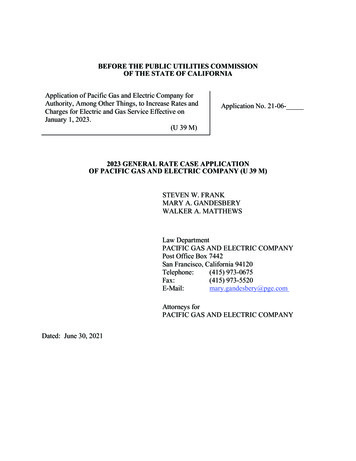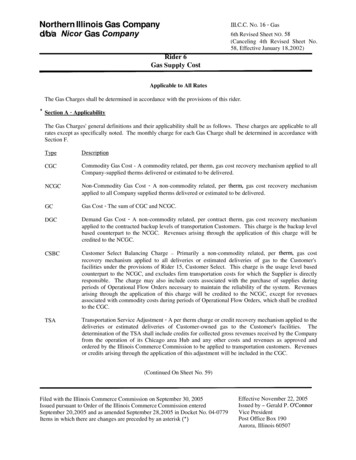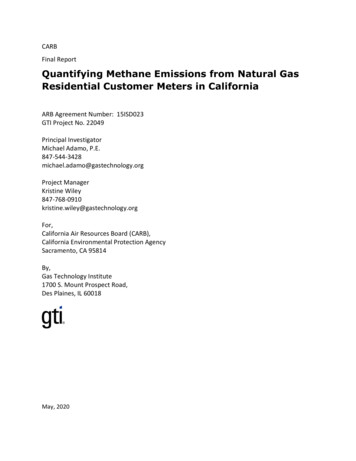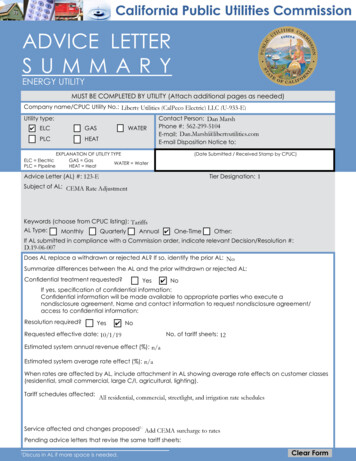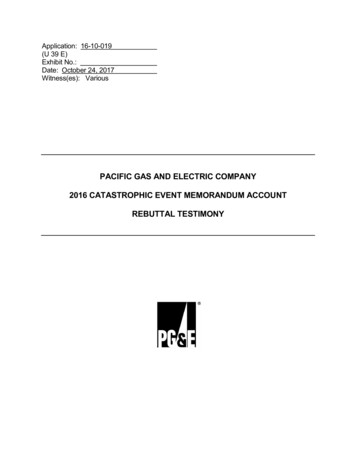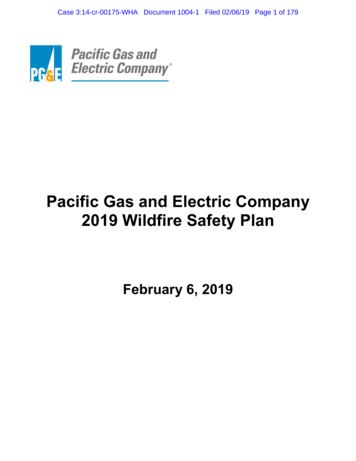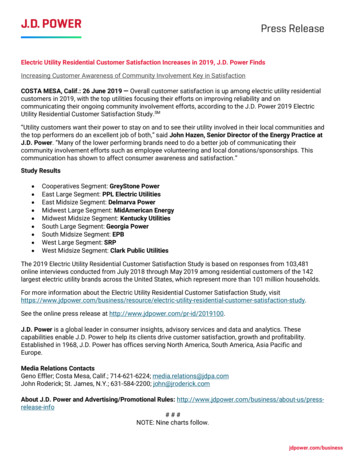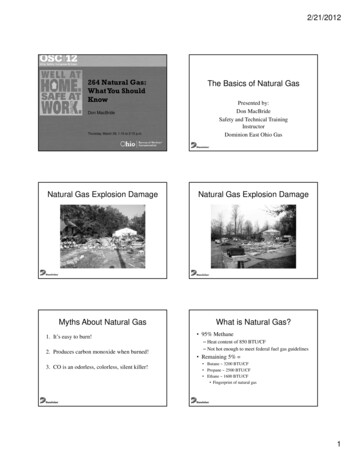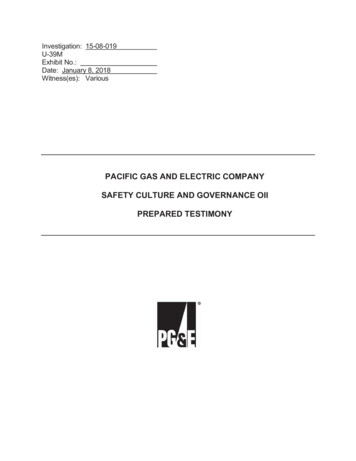
Transcription
Investigation: 15-08-019U-39MExhibit No.:Date: January 8, 2018Witness(es): VariousPACIFIC GAS AND ELECTRIC COMPANYSAFETY CULTURE AND GOVER1ANCE OIIPREPARED TESTIMONY
PACIFIC GAS AND ELECTRIC COMPANYSAFETY CULTURE AND GOVERNANCE OIIPREPARED TESTIMONYTABLE OF CONTENTSChapter1Appendix 1-ATitleIntroductionNickolas StavropoulosPG&E’s Safety Journey: 2010-2017 and Beyond2NorthStar RecommendationsAppendix 2-APG&E’s Implementation PlanAppendix 2-BPacific Gas and Electric Company Late-FiledExhibit on Executive Compensation and Safety3The One PG&E Occupational Health and SafetyPlan and NorthStar Data Request 144Appendix 3-AOne PG&E Occupational Health and Safety PlanAppendix 3-BThe One PG&E Occupational Health and SafetyPlan and Northstar Data Request 144Appendix 3-CCross Reference: NorthStar Data Request 144 andAssigned Commissioner Ruling Question 74Appendix 4-AWitnessBoard of DirectorsJohn HigginsTodd HohnLinda Y. H. ChengNuclear, Operations, and Safety Committee,Resolution of the Board of Directors of PG&ECorporation, May 31, 2017-i-
PACIFIC GAS AND ELECTRIC COMPANYSAFETY CULTURE AND GOVERNANCE OIIPREPARED TESTIMONYTABLE OF CONTENTS(CONTINUED)ChapterTitleAppendix 4-BPG&E Corporation Safety and Nuclear OversightCommittee Resolution of the Board of Directors ofPG&E Corporation, September 19, 2017Appendix 4-CCharter of the PG&E Corporation Board of DirectorsCompensation Committee, as Amended onSeptember 19, 2017Appendix 4-DSummary of Factors Considered for BoardMembership, PG&E Corporation and Pacific Gasand Electric Company, as of December 20, 20175PG&E’s Corrective Action ProgramAppendix 5-ACorrective Action Program OverviewAppendix 5-BCross Functional Cause Evaluation ReviewCommittee (CFCERC) CharterAppendix 5-CCFCERC Meeting SummariesAppendix 5-DSample Serious Incident Fatality (SIF) EventSummary EmailAppendix 5-ESample SIF Event Summary Email AttachmentAppendix 5-FEnterprise Root Cause Evaluation (RCE) TemplateAppendix 5-G Enterprise Apparent Cause Evaluation (ACE)TemplateAppendix 5-HCause Evaluation Training Program SummariesAppendix 5-ICorrective Action Review Board (CARB) Charter-ii-WitnessGary R. Close
PACIFIC GAS AND ELECTRIC COMPANYSAFETY CULTURE AND GOVERNANCE OIIPREPARED TESTIMONYTABLE OF CONTENTS(CONTINUED)ChapterTitleAppendix 5-JAppendix 5-KHierarchy of ControlsSample List of Procedures ModifiedAppendix 5-LSample List of Training Changes6Appendix 6-ASafety IncidentsWitnessTodd HohnSummary of Safety Incidents-iii-
PACIFIC GAS AND ELECTRIC COMPANYCHAPTER 1INTRODUCTION
PACIFIC GAS AND ELECTRIC COMPANYCHAPTER 1INTRODUCTIONTABLE OF CONTENTSA. Introduction . 1-1B. Witness Qualifications . 1-1C. Background . 1-2D. Organization of Testimony . 1-7E. Conclusion. 1-8Appendix1-i
12345PACIFIC GAS AND ELECTRIC COMPANYCHAPTER 1INTRODUCTIONA. IntroductionMy name is Nickolas Stavropoulos. I am the President and Chief Operating6Officer of Pacific Gas and Electric Company (PG&E or the Company). In that7capacity, I am responsible for the delivery of safe, reliable, affordable and clean8electric and gas service to 16 million people across PG&E's 70,000 square mile9service area in northern and central California.10The purpose of this testimony is to reinforce PG&E’s commitment to11continuing to improve our safety culture and performance in public, employee,12and contractor safety. While PG&E has made significant, measurable progress13with regard to many aspects of safety over the last several years, we recognize14that we still have more to do. When it comes to safety, no company is ever15done, and neither are we. We appreciate the opportunity this proceeding has16provided to receive thoughtful, meaningful feedback, and we look forward to17taking advantage of that feedback to help inform continuing improvements to18PG&E’s safety culture and performance and to help us on our mission to19become the safest, most reliable energy Company in the nation.2021B. Witness QualificationsI received a Bachelor's degree from Bentley University and master's degree22from Babson College. In addition, I have completed executive education23programs at Harvard and MIT. I am on the Boards of Directors for the24National Safety Council, the American Gas Association, and the Gas25Technology Institute.26In 2011, I joined PG&E as the Executive Vice President of Gas Operations.27In August 2015, I accepted the position of President of Gas Operations. I was28promoted to my current role of President and Chief Operating Officer of PG&E29effective March 1, 2017.30Prior to joining PG&E, I served as the Executive Vice President and Chief31Operating Officer for National Grid, where I was responsible for all aspects of its32U.S. gas distribution business. Prior to that, I was President of KeySpan Energy1-1
1Delivery, where I led the Company’s gas line of business (LOB). Prior to joining2KeySpan, I held several positions at Colonial Gas Company and Boston Gas.3C. Background4Any discussion about PG&E’s safety culture must begin with the tragic5San Bruno gas explosion and fire in September 2010. Since that event, PG&E6has looked inward to transform our leadership, governance, and processes, as7well as outward to benchmark and learn from companies across the country with8best-in-class safety records.9Over the past seven years, PG&E and PG&E Corporation have10implemented sweeping changes throughout the companies. A detailed11description of those changes is provided in a whitepaper, PG&E’s Safety12Journey: 2010-2017 and Beyond, which PG&E submitted to the California13Public Utilities Commission’s (Commission) Safety and Enforcement Division14earlier in this proceeding.1 In this chapter, I want to highlight some of the key15changes.In early 2011, PG&E announced that electric and gas operations would split1617into separate units, each with its own senior leader in charge. This split was18aimed at providing more commodity-specific focus on operations and safety, and19creating clear lines of oversight and accountability.In June 2011, PG&E’s then-Senior Vice President Geisha Williams was2021elevated to the newly created role of Executive Vice President of Electric22Operations for PG&E, and I joined the Company as Executive Vice President of23Gas Operations. In September 2011, Tony Earley—a seasoned and widely24respected utility leader—joined PG&E Corporation as Chairman, Chief Executive25Officer, and President. And over the last several years, the Company has26brought leaders from utilities across the country, and from various industries,27into all areas of the organization, including the Gas and Electric organizations.28Since 2011, the PG&E Corporation Board of Directors has added new29members with significant utility experience. To further strengthen its focus on30safety and operations, the Board created the Nuclear, Operations and Safety31Committee, led by Dr. Richard Meserve, former Chair of the Nuclear Regulatory32Commission, to oversee matters related to safety, operational performance, and1A copy of the whitepaper is attached to this chapter as Appendix 1-A.1-2
1compliance in the companies.2 To further highlight the importance of2compliance, which includes safety compliance, in 2015 the PG&E Corporation3Board renamed its Public Policy Committee as the Compliance and Public Policy4Committee, and amended its charter to help assure comprehensive and5well-coordinated oversight of both PG&E’s compliance and ethics programs and6the companies’ management of enterprise-level compliance risks.Recognizing the need to improve our safety culture, we engaged in an78intensive benchmarking process to learn from companies who had done so9successfully. We met with leaders from Alaska Airlines, Eastman Chemical, and10Norfolk Southern, among others, and brought several best practices to PG&E,11including daily operational calls (Alaska Airlines), process safety improvements12(Eastman Chemical), and non-punitive reporting (Federal Aviation13Administration, Eastman Chemical, and NS Railway).14Following benchmarking with General Electric, Ford, and DTE Energy,15PG&E launched an enhanced Integrated Planning Process in 2012, which16improved the integration of risk management into the planning and budgeting17process.3 In addition, our processes for risk management and asset18management have matured significantly and continue to mature. Risk19management processes have been established at the enterprise level, with20common direction across all of the LOBs. Each LOB has also worked to21continually improve its more detailed risk management processes.When it comes to safety, PG&E’s commitment to strengthening our safety2223culture and performance is embedded in the Company’s Mission, Vision, and24Culture that was unveiled in 2017. Figure 1-1 illustrates PG&E’s newly-updated25mission, vision and culture statements that are the foundation of how we run26our business.2Additional actions by the PG&E and PG&E Corporation Boards of Directors aredescribed in Chapter 4.3A more complete description of PG&E’s Integrated Planning Process is provided inChapter 3.1-3
FIGURE 1-1PG&E’S MISSION, VISION AND CULTURE STATEMENTSThe imperative to put safety first drives a commitment to a culture in which12employees understand that their actions every day must reflect that priority.3Companywide efforts include the utilization of safety committees, including4Grass Roots Safety Committees that involve front line field workers at the local5level, and a senior leadership level safety committee which engages the6executive team. The Company has also redefined the Contractor Safety7Program, established the enterprise-wide Corrective Action Program (CAP), and8established a Speak Up Program to reinforce and enable our employees’ and9contractors’ commitment to improving safety culture and performance.We measure our progress in safety culture and performance in a variety of1011ways. For example:12xWe have continued to pursue independent third-party verification of our13Company’s systems and processes from a number of different global14organizations. Over the past seven years, PG&E's gas business has earned15or qualified for international certifications including ISO 55001 and PAS 5516(asset management), API RP 1173 (pipeline safety management system),17and RC 14001 (process safety). PG&E is the only North American utility to18currently hold these third-party certifications. In addition, our Supply Chain19organization has achieved ISO 9001 certification for supplier quality.1-4
x1The bi-annual employee survey, with a strong 2016 participation rate of2approximately 81 percent of our 23,000 employees, includes specific3dimensions focused on safety culture such as whether employees feel4comfortable discussing safety concerns with their supervisors (93 percent5favorable) and whether they feel free to stop work if they believe conditions6are unsafe (93 percent favorable).x7The Corrective Action Program that began at Diablo Canyon Power Plant8has now been implemented across the entire Company. One metric we9track from CAP is the number of submittals that are anonymous. In 2017,10the average anonymous submission rate was 2 percent of all issues11submitted to CAP. Of the issues submitted to CAP that were related to12safety, only 0.2 percent were anonymous. CAP’s low anonymous13submission rate is a clear indication that employees are willing to speak up14and be recognized for their concerns and ideas about safety.4x15Performance, as measured by metrics in various areas, indicate significant16improvements since 2011. Examples include:17–Gas emergency response time has decreased by nearly 40 percent totop quartile performance.18–19The year-end backlog of non-hazardous workable grade two gas leakshas been reduced by 99 percent.2021–Dig-ins on the gas system have been reduced by 45 percent.22–Customer satisfaction with reliability of service has continued to23improve, with results in 2016 and 2017 showing the highest levels in the24last decade.–25Leading indicators for occupational safety and health that reinforce the26desired safety culture have been developed. For example, the quality of27corrective actions metric focuses attention on identifying and28implementing actions that prevent injury. Performance has improved29over 100 percent in the first two years of measurement.54More detail about the Corrective Action Program is presented in Chapter 5.5Improvement as of Nov 2017 since EOY results were not available at the time ofthis filing.1-5
PG&E’s commitment to driving these improvements has been demonstrated12in several ways, including:3xOn the gas system, investment in infrastructure improvement since 20114has been extensive, including replacement of over 200 miles of transmission5pipe and 585 miles of distribution pipe, hydro-testing over 1090 miles of6transmission pipe, enabling in-line inspection of 850 miles of transmission7pipe, and installing 291 automated valves on the transmission system.8xOn the electric system, infrastructure investment has also been extensiveover the last five years, including replacement of over 700 miles of overhead910distribution conductor, 49 miles of underground distribution cable, 40 miles11of network cable, and over 4,300 manhole cover replacements with venting12covers, as well as installing or replacing over 700 miles of transmission line.13xInvestment in the skills and competencies of our employees has also been a14strong focus. The Employee Knowledge and Skills Program has assessed15thousands of employees with regard to requirements to be a Qualified16Electrical Worker, and addressed skills gaps that were identified. In the fall17of 2017, the new Gas Safety Academy, a state-of-the-art facility for18hands-on training for gas workers, was opened in Winters, California.19xFifty percent of the Short-Term Incentive Plan is now based on safety, which20is industry leading.21While the progress we’ve made has been significant, we know that there is22more we can do and will do to reduce risk and improve safety culture and23performance. One example is our effort to embark on the implementation of an24Enterprise Safety Management System (ESMS). Over the last several years,25we have seen the positive effects a safety management system can have on26overall safety focus and performance through the experience we have gained27through the implementation of the Gas Safety Excellence Program in Gas28Operations, and through our involvement in the creation of API 1173, the new29recommended practice for gas pipeline safety management systems. Based on30this learning, we have committed to implementing an ESMS that will establish a31common framework across the entire enterprise for driving performance and32improvement in dimensions such as safety culture, asset management, process33safety, environmental management, and occupational health and safety. For34each dimension, we plan to utilize independent standards to guide our efforts1-6
1and measure our progress. We believe that the extent to which we plan to2establish our ESMS will be industry leading and will add significantly to our3efforts in improving safety performance.4D. Organization of Testimony5The remaining chapters of testimony are organized in response to the6questions presented in the Assigned Commissioner’s Ruling (ACR) dated7November 17, 2017.8Chapter 2 addresses the recommendations in the NorthStar Report.9In summary, PG&E agrees with all of the 67 recommendations and supports10their adoption by the Commission. PG&E has established an implementation11plan for the 61 recommendations directed at PG&E, included as Appendix 2-A.12As noted in those plans, implementation of 22 (36 percent) of the PG&E13recommendations is already complete and an additional 36 will have14implementation completed in 2018, bringing the total at that point to 95 percent15complete.16Chapter 3 addresses the One PG&E Occupational Health and Safety Plan17and NorthStar Data Request 144. PG&E has created a single, unified plan for18the Company for employee and contractor safety over the next five years, and it19has already begun implementing the plan. The safety initiatives that PG&E20described in response to Data Request 144 have, with few exceptions, been21completed and incorporated into PG&E’s operational processes.22Chapter 4 addresses the PG&E and PG&E Corporation Boards of Directors’23actions in response to the NorthStar Report, which include amending24governance and related documents to enhance and clarify the Boards’25responsibility for overseeing safety, formalizing requirements for26communications on safety matters, increasing the number of Board-level27meetings involving the Safety and Nuclear Oversight Committees, enhancing28safety expertise of the Boards, and confirming Board-level authority to consider29safety performance when establishing executive compensation.30Chapter 5 addresses PG&E’s CAP, including the current status of31implementing the program enterprise-wide, sharing of lessons learned, and an32early assessment of results.1-7
1Chapter 6 addresses the ACR questions regarding five safety incidents that2occurred in the 2013-2015 timeframe and PG&E’s actions in response to3those incidents.45E. ConclusionThe provision of electricity and natural gas has certain inherent hazards and6related safety implications for our employees, our contractors and the public.7Due to the nature of the commodities provided by the utility industry, there will8always be some risk. Our job, collectively, is to appropriately prioritize risks and9responsibly reduce them. Our focus has to be to continuously improve safety10performance over time. Our success, in large part, depends on our ability to11create a healthy, constructive safety culture.12The quest for safety and the nature of the regulatory structure require the13creation of a culture in which employees are encouraged to raise issues without14fear of retaliation and in which the utility interacts with its regulators transparently15and with integrity. A healthy safety culture is marked by open communication;16open communication both within the utility and between the utility and its17regulators.18The creation of a healthy and constructive safety culture is a never-ending19journey. Our commitment to our employees and the public is that we will work20with our regulators to be transparent about our challenges so that, collectively,21we can learn from them and improve.22This is our commitment, and it is critical to the success of our journey: we23will continually improve, we will nurture a culture of transparency and integrity,24and we will always put safety first.1-8
PACIFIC GAS AND ELECTRIC COMPANYCHAPTER 1APPENDIX 1-APG&E’S SAFETY JOURNEY: 2010-2017 AND BEYOND
PG&E’s Safety Journey:2010-2017 and BeyondPrepared forSafety Culture and Governance OII (I.15-08-019)April 3, 2017App1A-1
Table of ContentsExecutive Summary . 3San Bruno and Immediate Aftermath (September 2010–2012) . 11Improving Safety Through Integrated Planning (2013-2016) . 202017 and Looking Forward. 46Final Thoughts . 50Appendix . 51App1A-2
Executive SummaryThe San Bruno gas explosion and fire in September 2010 was a tragedy, and since that eventPG&E has been working to improve all aspects of its business that affect safety. In the lastsix years, PG&E has made progress across the company—a focus on safety is integrated intohow we plan, execute, and measure our work. We also recognize, and our experiences overthe last several years have affirmed, that there is more work to do in our mission to providesafe, reliable, affordable, and clean energy.The purpose of this document is to provide an overview of the actions PG&E has taken toimprove its safety culture and safety performance since the San Bruno accident. Thisexecutive summary provides an overview of PG&E’s safety philosophy, our journey sinceSan Bruno, and an overview of how we measure success. The remainder of the documentprovides further detail on the actions we have taken since San Bruno to support our safetyefforts summarized into the following three time periods:x San Bruno and Immediate Aftermath (September 2010 – 2012);x Improving Safety Through Integrated Planning (2013 –2016); andx 2017 and Looking Forward.The footnotes and appendices provided with this document cross-reference the various actionstaken and accomplishments with data request responses provided to the California PublicUtilities Commission (CPUC) and its consultant NorthStar.Our Safety Culture PhilosophyPG&E is driven to achieve an effective and robust safety culture, the goal of which is toensure the safety of the public and employee and contractor workforce. As the CPUC notedin its Safety Culture and Governance OII (I.15-08-019), this is a prerequisite for any utility’spositive safety performance record.The primary tools used to achieve this include leadership, governance, third-party and internalbenchmarking, training, risk identification and integrated planning to inform investmentneeds, performance management and compensation policies, and metrics. When these toolsare successfully deployed the result is a safety culture that demonstrates a collective andconsistent commitment to emphasize safety over competing goals.PG&E’s philosophy is that safety is each employee’s concern, priority, and job. Our safetyculture lives in our people and the way they approach their work every day. What we arebuilding is a mindset that values safety above all else and integrates safe practices into thework we perform. The safety culture at PG&E is formed as a result of the work, actions, anddecisions made every day that demonstrate that safety is our core value. It is not representedby words or slogans alone, but rather by choices made that demonstrate to our organizationthat nothing is more important than safety. Our goal is to integrate our safety-first philosophyand our approach to continuous improvement when we identify performance gaps.App1A-3
In cases where we find that an employee has failed to uphold our safety standards, or lacks theskills required to meet them, we respond not with termination of employment or immediatedisciplinary action, but coaching and training, so that people know they have nothing to fearfrom bringing problems to light. 1 We believe that a healthy safety culture comes fromemployees’ willingness to speak up about the deficiencies they see, share information, andhave crucial conversations with each other. Initiatives discussed later in this document suchas the Near Hit Program 2, Corrective Action Program (CAP) 3, and Speak Up for Safetycampaign 4 are all designed with this objective – to encourage and empower employees tospeak up for safety.Accountability for SafetyOur expectation is for the men and women on the front lines of PG&E’s operations to knowand understand why the accountability for safety rests with them. We enable this by givingthem authority to do what is necessary to protect the safety of the public, their fellowemployees, and our contractors. This manifests in employee actions including communicatingabout safety5, stopping or pausing a job for safety, and organization-wide stand-downs torevisit our procedures. All this is supported by cross-functional structures specificallydesigned to encourage and enable that response. 6Our leaders, too, are each personally accountable for instilling that culture by demonstrating –through their own actions – that PG&E’s values about safety hold true at every level of theenterprise. Front-line employees must be able to see for themselves that every successivelevel of leadership owns the safety of the teams they support, all the way to the most seniorlevels of leadership. They set the tone, expectation, and example that nothing comes beforesafety; not deadlines, productivity, or profit.Roles and Responsibilities – Our Organizational ApproachWhile we want every business operation to think about safety in the same way, we recognizethat one size does not fit all. That is why the primary responsibility for public, employee, andcontractor safety is located at the line of business (LOB) level. This approach is both strategicand practical and comes from understanding that the risks and hazards for each LOB are1See response to NorthStar Data Request (NS DR), attachment (Atch) 007 for a presentation that includesinformation on changes made to PG&E’s discipline policy in early 2011 as noted in NS 314, item 5 of Atch 001.Further information associated with these changes was provided in responses to NS DRs 025 and 027.2See first supplemental (Supp) response to NS DR 004, Atch 009 for a presentation on the Near Hits Program whichwas implemented enterprise-wide in mid-2012 as noted in NS 314, item 8 of Atch 001. Further information onPG&E’s Near Hits Program was provided in responses to NS DRs 212 Supp 002, 225, 726, 756, 861-862, and 877879.3See first supplemental response to NS DR 004, Atch 008 for a presentation on CAP. Further information on CAPwas provided in responses to NS DRs 061, 214, 218, 225, 271, 274, 404, 438, 446, 512, and 890.4See responses to NS DRs 256, 567, and 747 for information on the Speak up for Safety campaign.5See responses to NS DRs 066, 208-210, 259, 452, 531, and 745-746 for example safety-related communications toemployees.6See response to NS DR 770 for additional information.App1A-4
different. For example, we know that the practices involved in lowering electric linemen andequipment from helicopters onto electric transmission towers are very different than thoseneeded for gas workers toiling at the bottom of a trench. Likewise, the levels of rigor andredundancy necessary to operating a nuclear power plant would be unwarranted at anequipment yard. We also believe that the people closest to the work are the most expert aboutthe inherent risks associated with performing the work, and finding the ways to mitigate thoserisks.PG&E’s LOB leaders understand these realities, and how best to ensure the safety of theirteams and the communities they serve. Our Corporate Safety team is there to provide supportfor our safety work in the form of cross-collaboration process improvements anddeployments, training, technology deployment, incident investigation, compliance, metrics,best practice identification, and benchmarking. 7Use of Risk Assessment as a Basis for Plans and ActionsIn the years since San Bruno, we have matured our approach and employment of riskidentification and mitigation for our operations. 8 We see risk as a critical factor in how weprioritize multi-year capital investments that improve the safety and reliability of our systemoperations in Gas, Electric Transmission and Distribution (T&D), and Electric Generation.Risk management is foundational to the improvements we have made to employee safety andhealth, enabling us to target the activities and behaviors most likely to cause injury on thejob. 9 It has also been utilized for our Contractor Safety Program 10 to ensure we have skilledand qualified workers acting on our behalf. 11Risk assessment is embedded in the way we plan and budget for work and plan for rate cases.As discussed later, a component of our annual integrated planning process is dedicated to riskassessment; ensuring safety receives top priority when making budget decisions. We knowrisks are not static. We revisit our assessments each year to determine if we have effectivelymitigated risks, or if new ones have emerged. 12 Each LOB has a Risk and ComplianceCommittee (RCC) with standardized agendas and approaches to risk and compliance7See response to NS DR 004, Atch 004, for an overview of the roles and responsibilities of Corporate Safety.8See response to NS DR 004, Atch 003, for an overview of PG&E’s integrated planning process, including SessionD on risk management identification and planning. Further information on PG&E’s Enterprise Risk Managementprogram was provided in responses to NS DRs 168, 317, 472, and 6359See response to NS DR 771 for additional information.10See first supplemental response to NS DR 004, Atch 004 for a presentation on the Contractor Safety Programwhich was established in mid-2014 as noted in NS 314, item 15 of Atch 001. Further information on this programwas provided in responses to NS DRs 049, 054, 063, 072, 075-077, 084, 087-089, 096, 099-101, 108, 111-113, 183186, 195-203, 254, 309-310, 322, 372, 385-390, 426-428, 431-435, 490, 504, 506-510, 519, 521-524, 537, 543-544,553-558, 561-563, 585-599, 611, 643-649, 672 (Atchs 001 and 002), 724 (item 7), 758-761, 765, 863, and 867.11See response to NS DR 863 for additional information.12See response to NS DR 004, Atch 003, for an overview of PG&E’s integrated planning process. Furtherinformation on PG&E’s Integrated Planning Process was provided in responses to NS DRs 039-041, 205, 297, and663-666.App1A-5
management for their respective areas of responsibility. 13 T
1-2 1 Delivery, where I led the Company's gas line of business (LOB).Prior to joining 2 KeySpan, I held several positions at Colonial Gas Company and Boston Gas. 3 C. Background 4 Any discussion about PG&E's safety culture must begin with the tragic 5 San Bruno gas explosion and fire in September 2010. Since that event, PG&E 6 has looked inward to transform our leadership, governance, and .
